Solar eclipse of June 21, 2020
An annular solar eclipse occurred on June 21, 2020. A solar eclipse occurs when the Moon passes between Earth and the Sun, thereby totally or partly obscuring the image of the Sun for a viewer on Earth. An annular solar eclipse occurs when the Moon's apparent diameter is smaller than the Sun's, blocking most of the Sun's light and causing the Sun to look like an annulus (ring). An annular eclipse appears as a partial eclipse over a region of the Earth thousands of kilometres wide.
| Solar eclipse of June 21, 2020 | |
|---|---|
 Annularity as seen from Beigang, Yunlin, Taiwan | |
 Map | |
| Type of eclipse | |
| Nature | Annular |
| Gamma | 0.1209 |
| Magnitude | 0.994 |
| Maximum eclipse | |
| Duration | 38 sec (0 m 38 s) |
| Coordinates | 30.5°N 79.7°E |
| Max. width of band | 21 km (13 mi) |
| Times (UTC) | |
| Greatest eclipse | 6:41:15 |
| References | |
| Saros | 137 (36 of 70) |
| Catalog # (SE5000) | 9553 |
This solar eclipse occurred one lunar year after the July 2, 2019 eclipse.
Visibility
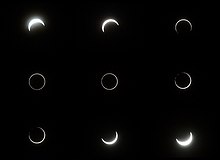
The central path of this annular eclipse passed through parts of Central and Eastern Africa, including Congo Republic, DR Congo, the Central African Republic, South Sudan, Ethiopia, Eritrea, and Djibouti; the southern Arabian Peninsula, including Yemen, Oman, and southern Saudi Arabia; parts of South Asia and the Himalayas, including southern Pakistan, northern India, Nepal, and Tibet; parts of East Asia, including South China and Taiwan, and part of Micronesia, including Guam.[1] A partial eclipse was visible throughout much of the rest of Africa, southeastern Europe, most of Asia (except the north part of Siberia and most of the island of Java), and in New Guinea and the north of Australia just before sunset. In Europe, the partial eclipse was visible for places southeast of the line roughly passing through Perugia, Miskolc, Lviv, and Yaroslavl.[1]
For Oman and India, it was the second annular eclipse 6 months after the December 2019 eclipse.[2]
Images


Gallery
 Partial from Sana'a, Yemen, 5:09 UTC
Partial from Sana'a, Yemen, 5:09 UTC Partial from Gyumri, Armenia, 5:45 UTC
Partial from Gyumri, Armenia, 5:45 UTC Partial from Colombo, Sri Lanka, 5:48 UTC
Partial from Colombo, Sri Lanka, 5:48 UTC_(cropped).jpg) Partial from Lahore, Pakistan, 6:49 UTC
Partial from Lahore, Pakistan, 6:49 UTC Partial from Kathmandu, Nepal, 6:51 UTC
Partial from Kathmandu, Nepal, 6:51 UTC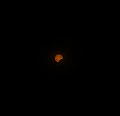 Partial from Bacoor, Philippines, 7:31 UTC
Partial from Bacoor, Philippines, 7:31 UTC Partial from Kolkata, India, 7:41 UTC
Partial from Kolkata, India, 7:41 UTC.jpg) Partial from Beijing, China, 7:50 UTC
Partial from Beijing, China, 7:50 UTC Partial from Jinan, China, 7:56 UTC
Partial from Jinan, China, 7:56 UTC Partial from Dongping County, Shandong, China, 7:56 UTC
Partial from Dongping County, Shandong, China, 7:56 UTC.jpg) Partial from Gandara, Samar, Philippines, 8:01 UTC
Partial from Gandara, Samar, Philippines, 8:01 UTC.jpg) Partial from Kaohsiung, Taiwan, 8:05 UTC
Partial from Kaohsiung, Taiwan, 8:05 UTC.jpg) Partial from Taichung, Taiwan, 8:09 UTC
Partial from Taichung, Taiwan, 8:09 UTC.jpg) From Chiayi, Taiwan, 8:13 UTC
From Chiayi, Taiwan, 8:13 UTC Partial from Yau Tong, Hong Kong, 8:08 UTC
Partial from Yau Tong, Hong Kong, 8:08 UTC Partial from Pangkal Pinang, Indonesia, 8:10 UTC
Partial from Pangkal Pinang, Indonesia, 8:10 UTC.jpg) From Xiamen, China, 8:11 UTC
From Xiamen, China, 8:11 UTC Time-lapse image of the eclipse in Xiamen
Time-lapse image of the eclipse in Xiamen.jpg) Partial from Fukuoka, Japan, 8:12 UTC
Partial from Fukuoka, Japan, 8:12 UTC Partial from San Jose del Monte, Philippines, 8:23 UTC
Partial from San Jose del Monte, Philippines, 8:23 UTC Partial from Iran
Partial from Iran.jpg) Eclipse progression as seen from Oria, Italy
Eclipse progression as seen from Oria, Italy_The_solar_eclipse_shadows_a_portion_of_Asia.jpg) The Moon's antumbra, as seen from the ISS
The Moon's antumbra, as seen from the ISS Partial from Surabaya, Indonesia, 8:22 UTC
Partial from Surabaya, Indonesia, 8:22 UTC Partial Solar Eclipse as seen from Chennai, Tamil Nadu.
Partial Solar Eclipse as seen from Chennai, Tamil Nadu.
People watching
 Hong Kong
Hong Kong.jpg) Taiwan
Taiwan.jpg) Taiwan
Taiwan Taiwan
Taiwan.jpg) kids
kids.jpg) Thailand
Thailand watchers in iran
watchers in iran Iran
Iran telescope
telescope
Related eclipses
Eclipses of 2020
Solar eclipses of 2018–2021
This eclipse is a member of a semester series. An eclipse in a semester series of solar eclipses repeats approximately every 177 days and 4 hours (a semester) at alternating nodes of the Moon's orbit.[3]
Note: Partial solar eclipses on February 15, 2018, and August 11, 2018, occurred during the previous semester series.
| Solar eclipse series sets from 2018–2021 | ||||||
|---|---|---|---|---|---|---|
| Ascending node | Descending node | |||||
| Saros | Map | Gamma | Saros | Map | Gamma | |
| 107 | 2017 July 23 | -2.14244 | 112 | 2018 January 17 | 1.78677 | |
117.jpg) Partial from Melbourne, Australia | 2018 July 13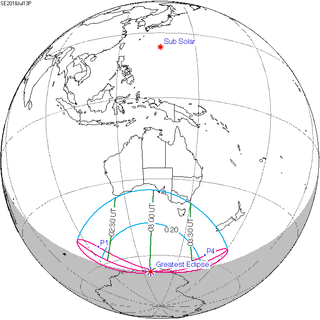 Partial |
-1.35423 | 122 Partial from Nakhodka, Russia | 2019 January 6 Partial |
1.14174 | |
127 La Serena, Chile | 2019 July 2 Total |
-0.64656 | 132.jpg) Jaffna, Sri Lanka | 2019 December 26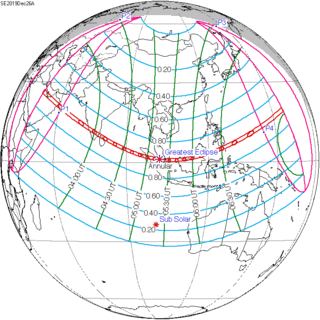 Annular |
0.41351 | |
137 Beigang, Yunlin, Taiwan | 2020 June 21 Annular |
0.12090 | 142 | 2020 December 14 Total |
-0.29394 | |
| 147 | 2021 June 10 Annular |
0.91516 | 152 | 2021 December 4 Total |
-0.95261 | |
| 157 | 2022 May 30 | 1.65174 | 162 | 2022 November 23 | -1.69875 | |
Saros 137
It is a part of Saros cycle 137, repeating every 18 years, 11 days, containing 70 events. The series started with partial solar eclipse on May 25, 1389. It contains total eclipses from August 20, 1533 through December 6, 1695, first set of hybrid eclipses from December 17, 1713 through February 11, 1804, first set of annular eclipses from February 21, 1822 through March 25, 1876, second set of hybrid eclipses from April 6, 1894 through April 28, 1930, and second set of annular eclipses from May 9, 1948 through April 13, 2507. The series ends at member 70 as a partial eclipse on June 28, 2633.
| Series members 30–40 occur between 1901 and 2100: | ||
|---|---|---|
| 30 | 31 | 32 |
 April 17, 1912 |
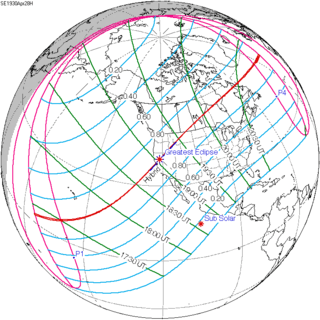 April 28, 1930 |
 May 9, 1948 |
| 33 | 34 | 35 |
 May 20, 1966 |
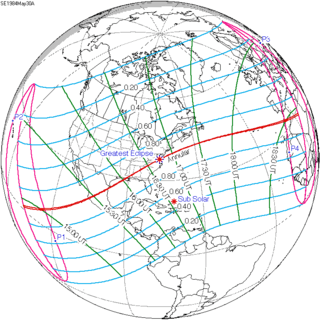 May 30, 1984 |
 June 10, 2002 |
| 36 | 37 | 38 |
 June 21, 2020 |
 July 2, 2038 |
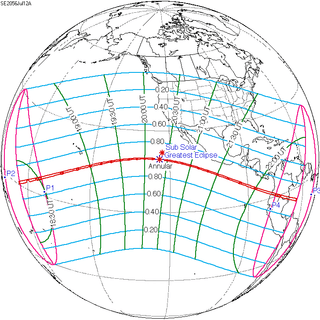 July 12, 2056 |
| 39 | 40 | |
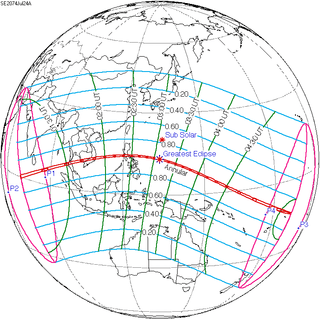 July 24, 2074 |
 August 3, 2092 | |
Inex series
This eclipse is a part of the long period inex cycle, repeating at alternating nodes, every 358 synodic months (≈ 10,571.95 days, or 29 years minus 20 days). Their appearance and longitude are irregular due to a lack of synchronization with the anomalistic month (period of perigee). However, groupings of 3 inex cycles (≈ 87 years minus 2 months) comes close (≈ 1,151.02 anomalistic months), so eclipses are similar in these groupings. In the 18th century:
- Solar Saros 127: Total Solar Eclipse of 1731 Jan 08
- Solar Saros 128: Annular Solar Eclipse of 1759 Dec 19
- Solar Saros 129: Annular Solar Eclipse of 1788 Nov 27
| Inex series members between 1801 and 2200: | ||
|---|---|---|
| Near lunar perigee | After lunar apogee Before lunar perigee |
Before lunar apogee After lunar perigee |
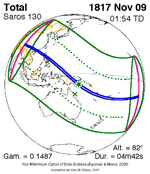 November 9, 1817 (Saros 130) |
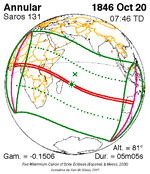 October 20, 1846 (Saros 131) |
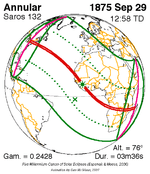 September 29, 1875 (Saros 132) |
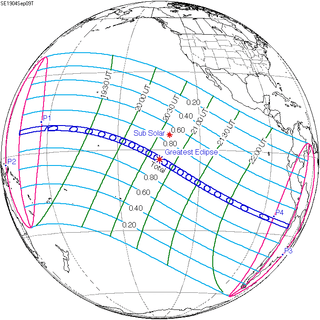 September 9, 1904 (Saros 133) |
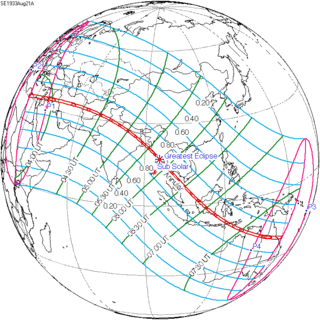 August 21, 1933 (Saros 134) |
 July 31, 1962 (Saros 135) |
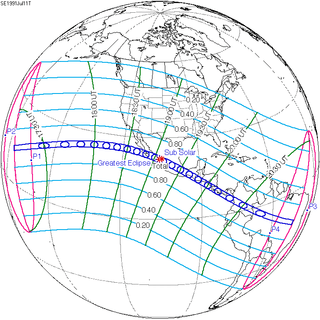 July 11, 1991 (Saros 136) |
 June 21, 2020 (Saros 137) |
 May 31, 2049 (Saros 138) |
 May 11, 2078 (Saros 139) |
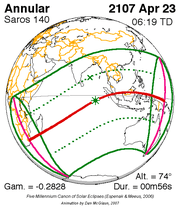 April 23, 2107 (Saros 140) |
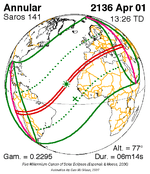 April 1, 2136 (Saros 141) |
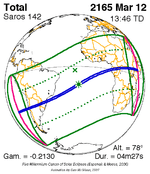 March 12, 2165 (Saros 142) |
 February 21, 2194 (Saros 143) |
|
In the 23rd century:
- Solar Saros 144: Annular Solar Eclipse of 2223 Feb 01
- Solar Saros 145: Total Solar Eclipse of 2252 Jan 12
- Solar Saros 146: Annular Solar Eclipse of 2280 Dec 22
Metonic series
The metonic series repeats eclipses every 19 years (6939.69 days), lasting about 5 cycles. Eclipses occur in nearly the same calendar date. In addition, the octon subseries repeats 1/5 of that or every 3.8 years (1387.94 days). All eclipses in this table occur at the Moon's ascending node.
| 21 eclipse events between June 21, 1982, and June 21, 2058 | ||||
|---|---|---|---|---|
| June 21 | April 8–9 | January 26 | November 13–14 | September 1–2 |
| 107 | 109 | 111 | 113 | 115 |
| June 21, 1963 | April 9, 1967 | January 26, 1971 | November 14, 1974 | September 2, 1978 |
| 117 | 119 | 121 | 123 | 125 |
 June 21, 1982 |
 April 9, 1986 |
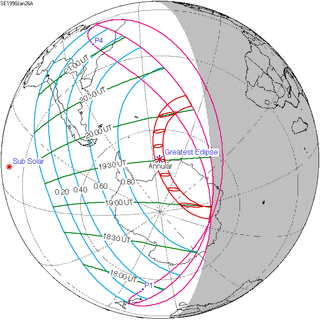 January 26, 1990 |
 November 13, 1993 |
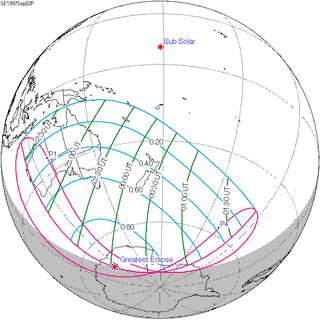 September 2, 1997 |
| 127 | 129 | 131 | 133 | 135 |
 June 21, 2001 |
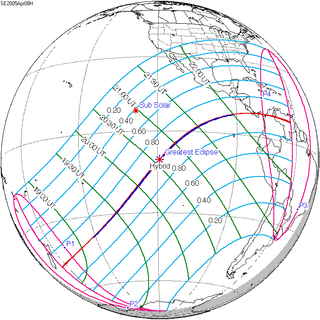 April 8, 2005 |
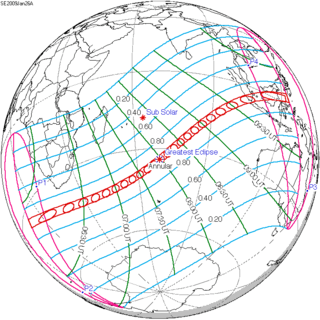 January 26, 2009 |
 November 13, 2012 |
 September 1, 2016 |
| 137 | 139 | 141 | 143 | 145 |
 June 21, 2020 |
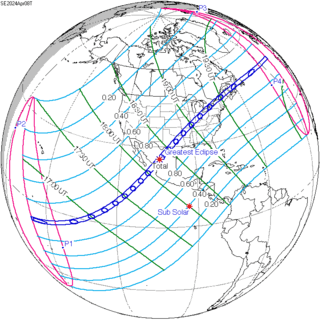 April 8, 2024 |
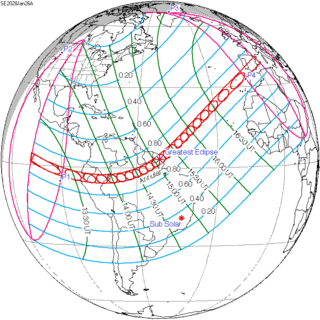 January 26, 2028 |
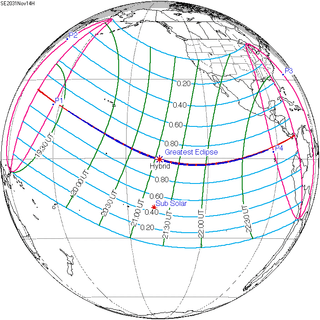 November 14, 2031 |
 September 2, 2035 |
| 147 | 149 | 151 | 153 | 155 |
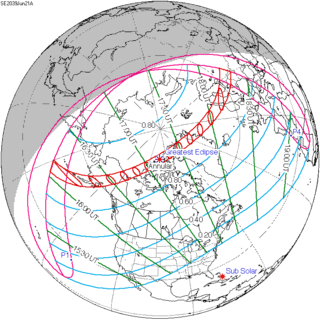 June 21, 2039 |
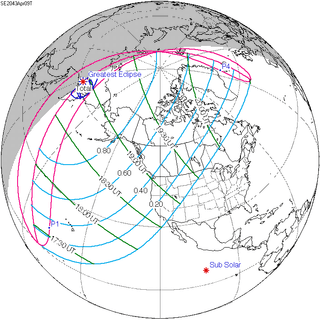 April 9, 2043 |
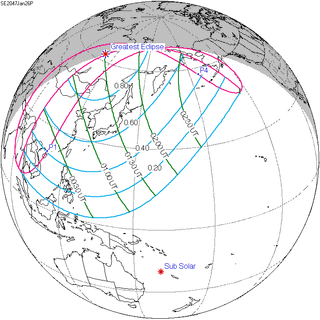 January 26, 2047 |
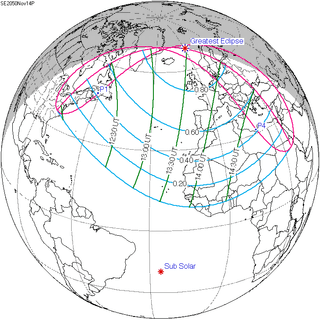 November 14, 2050 |
 September 2, 2054 |
| 157 | ||||
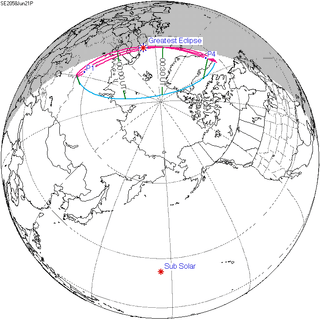 June 21, 2058 | ||||
Notes
- "Annular Solar Eclipse on June 21, 2020". www.timeanddate.com. Retrieved 2019-12-26.
- World Atlas of Solar Eclipse Paths
- van Gent, R.H. "Solar- and Lunar-Eclipse Predictions from Antiquity to the Present". A Catalogue of Eclipse Cycles. Utrecht University. Retrieved 6 October 2018.
References
- Earth visibility chart and eclipse statistics Eclipse Predictions by Fred Espenak, NASA/GSFC
External links
| Wikimedia Commons has media related to Solar eclipse of 2020 June 21. |
.jpg)
